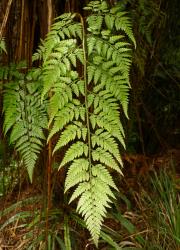Terrestrial or epiphytic, evergreen ferns. Rhizomes long-creeping or climbing, scaly. Rhizome scales non-clathrate, ovate or narrowly ovate, margins entire or minutely toothed, attached at base or peltate, concolorous, pale to dark brown. Fronds monomorphic, not bulbiferous. Stipes and rachises scaly, adaxially sulcate. Laminae 2–3-pinnate, coriaceous, scaly. Veins free. Sori round, borne on abaxial surface, away from the margin, in 1 row either side of midrib; indusia round, peltate. Spores monolete; perispores coarsely rugose or tuberculate, smooth on the surface.
A genus of seven species included in the subfamily Elaphoglossoideae (Bauret et al. 2017).
Rumohra is considered to be monophyletic, and sister to Megalastrum, with the two genera together sister to Lastreopsis sens. str. (Labiak et al. 2014).
Only one widespread species, Rumohra adiantiformis, is present in New Zealand.
In New Zealand, the sole species of Rumohra is distinguished by its terrestrial or climbing habit, long-creeping rhizomes, 2–3-pinnate scaly fronds, and round sori protected by round indusia. The spores are coarsely rugose or tuberculate, and smooth on the surface (Large & Braggins 1991).
Rumohra is a small genus of seven species, with three endemic to Madagascar, one to Juan Fernandez Island, and two to Brazil. One species is widespread in tropical and south temperate regions from South and Central America to Africa, Madagascar, Australasia, New Guinea and the South Pacific (Sundue et al. 2013; Labiak et al. 2014; Bauret et al. 2017). One non-endemic species in New Zealand.
| Category | Number |
|---|---|
| Indigenous (Non-endemic) | 1 |
| Total | 1 |
The base chromosome number in Rumohra is x = 41 (Kramer 1990).




